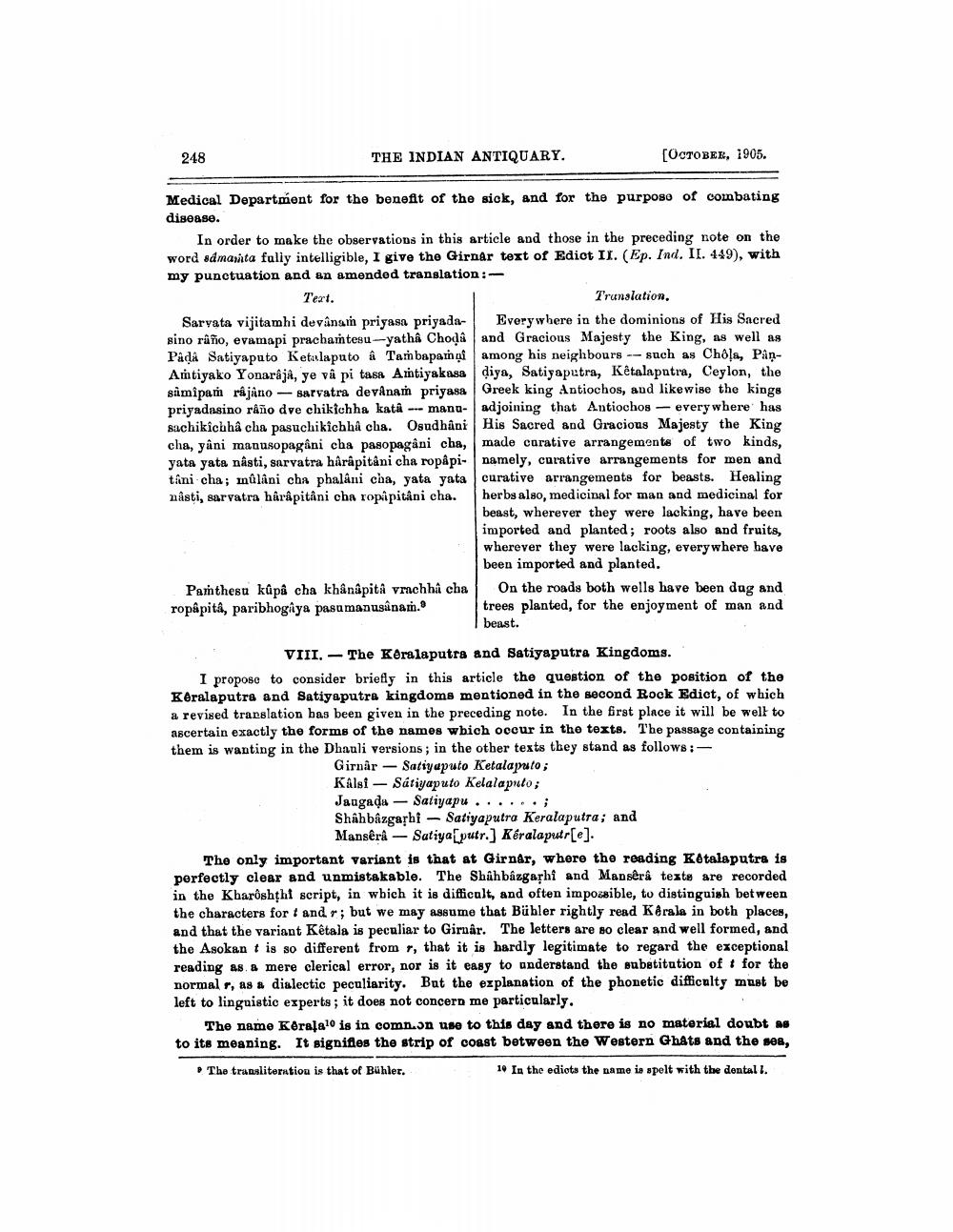________________
248
THE INDIAN ANTIQUARY.
[OCTOBER, 1905.
Medical Department for the benefit of the sick, and for the purpose of combating disease.
In order to make the observations in this article and those in the preceding note on the word samarita fully intelligible, I give the Girnår text of Ediot II. (Ep. Ind. II. 449), with my punctuation and an amended translation:Text.
Translation. Sarvata vijitamhi devânam priyasa priyada- Everywhere in the dominions of His Sacred sino raño, evamapi prachamtesu-yatha Chods and Gracious Majesty the King, as well as Pada Satiyaputo Ketalaputo a Tarbapami among his neighbours -- such as Chols, PanAmtiyako Yonarâjâ, ye va pi tasa Amtiyakasa diya, Satiyaputra, Kêtalaputra, Ceylon, the simîpam rájáno - sarvatra devånam priyasa Greek king Antiochos, and likewise the kings priyadasino råño dve chikichha katå --- mana- adjoining that Antiochos - everywhere has sachikichhâ cha pasuchikichhà cha. Osudhani Bis Sacred and Gracious Majesty the King cha, yâni manusopagani cha pasopagani cha, made carative arrangements of two kinds, yata yata násti, sarvatra hârâpitâni cha ropapi- namely, corative arrangements for men and tani cha; unulani cha phalani cha, yata yata curative arrangements for beasts. Healing nâsti, sarvatra hârâpitâni cha ropipitâni cha. herbs also, medicinal for man and medicinal for
beast, wherever they were lacking, have been imported and planted; roots also and fruits, wherever they were lacking, everywhere have
been imported and planted. Panthesu kúpa cha khânâpitá vrchha cha On the roads both wells have been dug and ropâpita, paribhogaya pasu manusanam. trees planted, for the enjoyment of man and
I beast.
VIII. - The Koralaputra and Satiyaputra Kingdoms. I propose to consider briefly in this article the question of the position of the Keralaputra and Satiyaputra kingdoms mentioned in the second Rock Edict, of which a revised translation has been given in the preceding note. In the first place it will be well to ascertain exactly the forms of the names wbich occur in the texts. The passage containing them is wanting in the Dhauli versions; in the other texts they stand as follows:
Girnar - Sariyaputo Ketalaputo; Kalsi - Satiyaputo Kelalapulo; Jangada - Satiyapu ......; Shahbazgashi - Satiyaputra Keralaputra; and
Mansêrå - Satiyaputr.] Keralaputr[e]. The only important variant is that at Girnar, where the reading Kotalaputra is perfectly clear and unmistakable. The Shahbâzgashi and Mansêra texte are recorded in the Kharoshth script, in which it is difficult, and often impossible, to distinguish between the characters for t and r; but we may assume that Bühler rightly read Kerala in both places, and that the variant Kêtala is peculiar to Girar. The letters are so clear and well formed, and the Asokan t is so different from r, that it is hardly legitimate to regard the exceptional reading as a mere clerical error, nor is it easy to understand the substitution of t for the normal, as a dialectic peculiarity. But the explanation of the phonetic difficulty must be left to linguistic experts; it does not concern me particularly.
The name Kerala10 is in comn.un use to this day and there is no material doubt as to its meaning. It signifies the strip of coast between the Western Ghats and the sea,
The transliteration is that of Buhler.
10 In the ediots the name is spelt with the dentall.




